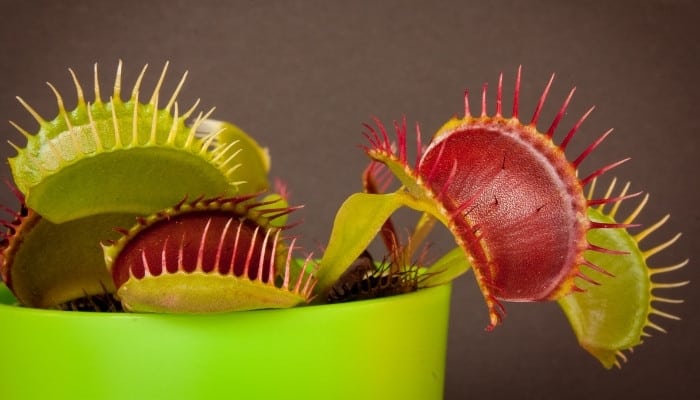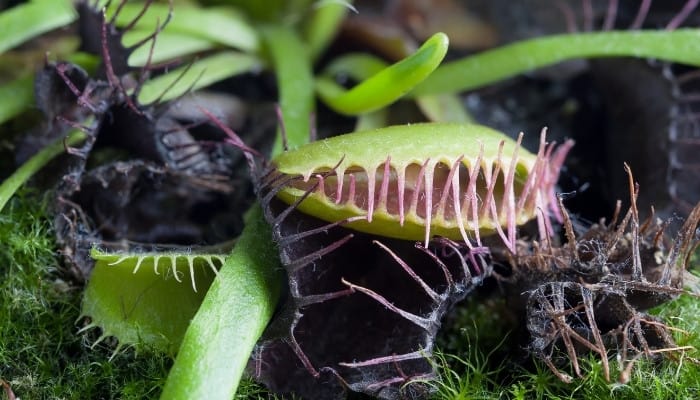There is a common belief that Venus fly traps are delicate plants and have a hard time surviving.
While they can be tricky to grow if you don’t provide the essential care the plant requires, this is true for most plants!
So, before you discard your monster-licious plant, read this helpful guide!
The root cause for the Venus Fly Traps deathly pallor is often down to a few simple errors that are easily rectified if you know how!
Why are my venus fly traps turning black? Many factors can cause a Venus fly trap to turn black. Common reasons include inappropriate food, using tap water to irrigate, insufficient light, incorrect planting soil, overfeeding or feeding the wrong food, plant stress, mineral leaching, and natural trap die-off.
Follow the helpful tips and advice found below to keep your Venus fly trap happily eating bugs while remaining a healthy shade of green!
Reasons Venus Fly Traps Turn Black
Unfortunately, incorrect plant care is the primary reason for a Venus fly trap to turn back. Unfortunately, this is not good news for plant parents because it’s ultimately down to us!
Too much love or a lack of knowledge can quickly lead to the deathly pallor of the Venus fly trap!
1. Water Issues
The type and amount of water used to soak the plant is important.
Tap water contains dissolved minerals, such as chlorine, magnesium, calcium, and sodium, which are a lethal cocktail to the Venus fly trap.
If used regularly, these minerals build up in the soil and cause the plant to become sickly, turn black, and die. Instead, use distilled water or rainwater when watering your plant.
2. Insufficient Light
Venus fly traps are light lovers and require a minimum of six hours for optimum growth. However, they are much healthier plants when they receive more than 10 hours of sunlight.
If your home is relatively dark, you will need to consider providing additional light through artificial lighting using fluorescent bulbs or LED lights.
This small, gooseneck-style grow light, for example, would be ideal.
Poor lighting can result in droopy, discolored foliage and cause the plant to stop developing healthy leaves and traps.
3. Incorrect Type of Soil
In their natural environment, Venus fly traps often grow in nutrient-poor soil, which is why they have adapted to eating insects.
Using heavy, nutrient-rich soil can cause the plant to droop and die. The soil used to pot Venus fly traps should be nutrient and mineral free with excellent drainage.
A good soil mixture to use is a mix containing sphagnum moss and perlite.
The moss will aid in moisture retention while the perlite improves drainage and allows air to the roots. Mix two parts sphagnum moss to one part perlite.
4. Overfeeding
Manual feeding is often a necessity for those of us with indoor Venus fly trap beauties. When feeding the plant manually, you should follow a few rules.
First, only feed the plant every two to four weeks as it can take a few weeks for the plant to consume a small bug.
Provide insects that are appropriately sized or cut to size. Feed one trap at a time as the plant cannot consume multiple insects at a time.
Also, do not feed in the dormancy period. Remember Venus fly traps eat more than just flies; they also enjoy a diet of spiders, ants, crickets, and beetles.
5. Wrong Type of Food
Feeding your plant with human food can result in a sickly, blackened plant culminating in plant death.
For example, raw meat, cheese, sausage, and hamburgers are toxic to the Venus fly trap.
Instead of digesting these complex foods, the trap starts to die and the food rots, attracting bacteria and disease.
Providing your Venus fly trap with the appropriate diet of insects, spiders, and bugs regularly will ensure healthy plant growth.
Alternative foods you can use are mealworms and other freeze-dried insects.

6. Normal Winter Dormancy
Venus fly traps require a dormancy period to recuperate after the growing season. This usually occurs in the winter months.
During this time, the plant will naturally die back and turn black. When this happens, trim off the dead growth and repot the plant if required. The plant will start to grow again in the spring.
7. Natural Die-Off
Part of the plant life cycle will see older traps on the rosette turn black and die. This is especially true if the trap has caught and consumed a few insects over a period of time.
If the plant is still producing new foliage, then it is healthy.
8. Stress
Poor growing conditions or environmental changes can be stressful to the Venus fly trap.
Things like repotting or sudden repositioning of the plant can cause plant stress, often resulting in it turning black.
In addition, poor lighting conditions, inadequate watering techniques, excessive pruning, and incorrect soil can cause immense stress to the plant.
9. Planting Container Is Leaching Minerals
The best containers for a Venus fly trap are made from plastic and glazed ceramic. These containers will not contain minerals that can leach into the soil and kill or stunt your plant’s growth.
Terra cotta, cement, and concrete containers are not suitable for the Venus Fly Trap.
How To Prevent Venus Fly Traps From Turning Black
To keep your Venus Fly Trap from turning black you need to ensure the growing conditions are correct. Here are a few tips to keep your Venus Fly Trap healthy and green.
- Feed the plant only bugs and insects, no human food!
- Water the plant with mineral-free water, rainwater is excellent.
- Place the plant in full sun with access to light for at least six hours.
- Provide the plant with nutrient-poor soil, avoid compost and fertilizer.
- Don’t overfeed, feed one trap at a time.
Related Questions:
Should You Cut Off Black Venus Fly Traps?
Pruning black traps will improve health, prevent pests and mold, reduce overcrowding, and keep the plant looking nice and tidy.
However, there are a few basic rules you should follow. Don’t trim the trap as soon as it changes color. Wait for it to wither and dry thoroughly before removing it.
Do not pull the leaves off; use a sharp pair of scissors to snip the entire leaf off at the base without touching the bulb.
Can You Save a Dying Venus Fly Trap?
First, check that you are using the correct soil and immediately repot if you have used standard soil or potting mix.
Second, ensure the water you are using is mineral free, and repot if necessary. Third, ensure the plant receives at least six hours of direct sunlight or artificial light.
Finally, check the plant for pests or diseases, and ensure you’re feeding the plant correctly.
Conclusion
Successfully growing an indoor Venus fly trap can be tricky.
As a caring plant parent, the moment you notice your carnivorous family member becoming sickly, you need to make immediate changes.
These simple changes will prevent it from turning black and dying. Simply follow the guidelines above to avoid making these mistakes, and growing a Venus fly trap will be as easy as one, two, three!

